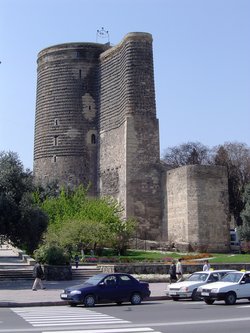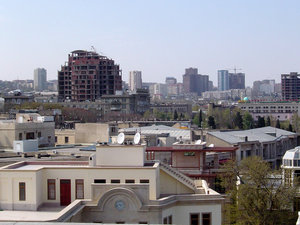Baku
|
|
- This article is about the Azeri capital. For other uses, see Baku (disambiguation).
Baku (or Bakı [Baky]) pronounced ba-KEY, Bakı in Azeri, is the capital of Azerbaijan. It is located on the southern shore of the Apsheron Peninsula, at Template:Coor dm. Its history dates back to 1st millennium BC. Earliest written evidence is from 6th century AD, however. Population (2003 census): 1,900,000. About 3 million people in metropolitan area(due to high numbers of refugees and IDPs).
| Contents |
History

Baku is the place of an important fire temple of the Iranian religion of Zoroastrianism which was prevalent in the whole region in the older times. For most of its history Baku was an integrated part of Persia. The first written reference to Baku dates from 885, although archaeologists have found remains of a settlement predating by several centuries the birth of Jesus. The city became important after an earthquake destroyed Shemakha and the of the 12th century and the Shirvanshah, Ahistan I, made Baku the new capital. In 1813 Russia signed the Treaty of Gulistan with Persia by which Baku and most of the Caucasus region were ceceded from Iran and was annexed to Russia.
There are a few theories about the origin of the name, the most widely known being that Baku comes from the Persian word Bagh-Kuh (the Mount of God). The Name of Baku is also popularly explained as coming from the Persian word "bad kube", meaning "city of winds". The climate is hot and dry in the summer, cool and wet in the winter, with gale-force winds that sweep through on occasion, caused by masses of polar air; however, snow is rare at 28 metres below sea level, and temperatures on the coast rarely get down to freezing.
Baku is located on the western shore of the Caspian Sea and is Azerbaijan's largest city, one of very few places where Soviet citizens could actually experience beaches or relax in now-dilapidated spa complexes overlooking the salty Caspian Sea. The old Inturist Hotel is still one of Baku's largest.
Today's Baku is really three cities: the Old Town (İçəri Şəhər)), the boomtown and the Soviet-built town.
The centre of Baku is the old town, which is also a fortress. The walled city of Baku (called "Icheri sheher" meaning "Inner town") became in December 2000 the first location in Azerbaijan classified as World Heritage Site by UNESCO. Most of the walls and towers, strengthened after the Russian conquest in 1806, survive. This section is picturesque, with its maze of narrow alleys and ancient buildings. Wander the cobbled streets past the Palace of the Shirvanshahs, two caravansaraies (ancient inns), the 11th century Maiden Tower (nice view of the harbor), the baths and the Djuma Mosque (it used to house the Carpet and Applied Arts Museum, but now is a mosque again; the carpets got moved to the former Lenin museum). The old town also has dozens of small mosques, often without any particular sign to distinguish them from the next building.
The boomtown, south of the old city, was built after massive petroleum exploitation began nearly a century ago and has interesting beaux-arts architecture. Fine arts, history and literature museums are located there, all housed in the mansions of pre-Revolutionary millionaires.
Modern Baku spreads out from the walls, its streets and buildings rising up hills that rim the Bay of Baku. Greater Baku is divided into 11 districts and 48 townships. Among these are townships on islands in the bay and one island town built on stilts in the Caspian Sea, 100 kilometres from Baku proper ('Oil Rocks').
The Martyr's Cemetery, formerly the Kirov park, is dedicated to the memory of those who lost their lives during the war with Armenia and also to the 137 people who were killed on January 19 and 20, 1990 when Soviet tanks and troops took to the streets of Baku. Photographs of victims featured on each tombstone are sobering and poignant. Now 20 January has become a national holiday of deep emotional meaning.
The basis of Baku's economy is petroleum. The existence of petroleum has been known since the 8th century. By the 15th century oil for lamps was obtained from surface wells. Commercial exploitation began in 1872, and by the beginning of the 20th century the Baku oil field was the largest in the world. Towards the end of the 20th century much of the land's petroleum had been exhausted, and drilling had extended into the sea. Baku ranks as one of the largest centres for the production of oil industry equipment. The World War II Battle of Stalingrad was fought to determine who would have control of the Baku oil fields. Fifty years before the battle, Baku produced half of the world's oil supply: Azerbaijan and the United States are the only two countries ever to have been the world's majority oil producer.
Constructions
Famous people from Baku
Famous people born in Baku include chess grandmasters Garry Kasparov and Teimour Radjabov. Kasparov was the top-ranked player in the world for many years -- he was driven out of Baku along with most of the other Armenians, and has said he will never return. Lev Davidovich Landau [1] (http://nobelprize.org/physics/laureates/1962/landau-bio.html) was born in Baku on January 22, 1908. He was a Nobel Prize Laureate in Physics in 1968.
External links
- American Embassy in Baku Azerbaijan (http://www.usembassybaku.org)
- British Embassy in Baku Azerbaijan (http://www.britishembassy.gov.uk/servlet/Front?pagename=OpenMarket/Xcelerate/ShowPage&c=Page&cid=1056117176152)
Photos of Baku
- Baku in Emporis (http://www.emporis.com/en/il/pc/?id=100196&aid=3&sro=1)
Baku can also mean:
- A kind of Japanese spirit, see baku (spirit)
- A Monster Rancher character, see Baku (Monster Rancher)bg:Баку
ca:Bakú da:Baku de:Baku et:Bakuu es:Bakú eo:Baku fr:Bakou he:באקו nl:Bakoe ja:バクー no:Baku pl:Baku ru:Баку sk:Baku fi:Baku sv:Baku tt:Bakı zh:巴库


